Binary Computer-Generated Holograms by Simulated-Annealing Binary Search
Abstract
:1. Introduction
2. Method
2.1. Direct Binary Search
2.2. Simulated Annealing
2.3. Stimulated Annealing Binary Search
3. Determination of the Parameters in SABS
4. Results and Discussions
5. Conclusions
Author Contributions
Funding
Data Availability Statement
Conflicts of Interest
References
- Poon, T.-C. (Ed.) Digital Holography and Three-Dimensional Display; Springer: Berlin, Germany, 2006. [Google Scholar]
- He, Z.; Sui, X.; Jin, G.; Chu, D.; Cao, L. Optimal quantization for amplitude and phase in computer-generated holography. Opt. Express 2021, 29, 119–133. [Google Scholar] [CrossRef] [PubMed]
- Zhang, H.; Zhao, Y.; Cao, L.; Jin, G. Layered holographic stereogram based on inverse Fresnel diffraction. Appl. Opt. 2016, 55, A154–A159. [Google Scholar] [CrossRef] [PubMed]
- Zhang, Z.; Liu, J.; Gao, Q.; Duan, X.; Shi, X. A full-color compact 3D see-through near-eye display system based on complex amplitude modulation. Opt. Express 2019, 27, 7023–7035. [Google Scholar] [CrossRef] [PubMed]
- Park, M.-C.; Lee, B.-R.; Son, J.-Y.; Chernyshov, O. Properties of DMDs for holographic displays. J. Mod. Opt. 2015, 62, 1600–1607. [Google Scholar] [CrossRef]
- Takaki, Y.; Yokouchi, M. Speckle-free and grayscale hologram reconstruction using time-multiplexing technique. Opt. Express 2011, 19, 7567–7579. [Google Scholar] [CrossRef]
- Mori, Y.; Fukuoka, T.; Nomura, T. Speckle reduction in holographic projection by random pixel separation with time multiplexing. Appl. Opt. 2014, 53, 8182–8188. [Google Scholar] [CrossRef]
- Lee, B.; Yoo, D.; Jeong, J.; Lee, S.; Lee, D.; Lee, B. Wide-angle speckleless DMD holographic display using structured illumination with temporal multiplexing. Opt. Lett. 2020, 45, 2148–2151. [Google Scholar] [CrossRef]
- Sando, Y.; Barada, D.; Yatagai, T. Full-color holographic 3D display with horizontal full viewing zone by spatiotemporal-division multiplexing. Appl. Opt. 2018, 57, 7622–7626. [Google Scholar] [CrossRef]
- Takahashi, T.; Shimobaba, T.; Kakue, T.; Ito, T. Time-Division Color Holographic Projection in Large Size Using a Digital Micromirror Device. Appl. Sci. 2021, 11, 6277. [Google Scholar] [CrossRef]
- Takaki, Y.; Matsumoto, Y.; Nakajima, T. Color image generation for screen-scanning holographic display. Opt. Express 2015, 23, 26986–26998. [Google Scholar] [CrossRef]
- Li, J.; Smithwick, Q.; Chu, D. Full bandwidth dynamic coarse integral holographic displays with large field of view using a large resonant scanner and a galvanometer scanner. Opt. Express 2018, 26, 17459–17476. [Google Scholar] [CrossRef] [PubMed]
- Chlipala, M.; Kozacki, T. Color LED DMD holographic display with high resolution across large depth. Opt. Lett. 2019, 44, 4255–4258. [Google Scholar] [CrossRef] [PubMed]
- Masuda, K.; Saita, Y.; Toritani, R.; Xia, P.; Nitta, K.; Matoba, O. Improvement of Image Quality of 3D Displayby Using Optimized Binary Phase Modulation and Intensity Accumulation. J. Disp. Technol. 2016, 12, 472–477. [Google Scholar] [CrossRef]
- Liu, J.-P.; Wu, M.-H.; Tsang, P.W.M. 3D display by binary computer-generated holograms with localized random down-sampling and adaptive intensity accumulation. Opt. Express 2020, 28, 24526–24537. [Google Scholar] [CrossRef]
- Liu, J.-P.; Lin, Y.-C.; Jiao, S.; Poon, T.-C. Performance Estimation of Intensity Accumulation Display by Computer-Generated Holograms. Appl. Sci. 2021, 11, 7729. [Google Scholar] [CrossRef]
- Cheung, W.K.; Tsang, P.; Poon, T.-C.; Zhou, C. Enhanced method for the generation of binary Fresnel holograms based on grid-cross downsampling. Chin. Opt. Lett. 2011, 9, 120005. [Google Scholar] [CrossRef]
- Tsang, P.; Poon, T.-C.; Cheung, W.K.; Liu, J.-P. Computer generation of binary Fresnel holography. Appl. Opt. 2011, 50, B88–B95. [Google Scholar] [CrossRef]
- Tsang, P.; Cheung, W.K.; Poon, T.-C.; Liu, J.-P. An enhanced method for generation of binary Fresnel hologram based on adaptive and uniform grid-cross down-sampling. Opt. Commun. 2012, 285, 4027–4032. [Google Scholar] [CrossRef]
- Tsang, P.W.M.; Poon, T.-C.; Jiao, A.S.M. Embedding intensity image in grid-cross down-sampling (GCD) binary holograms based on block truncation coding. Opt. Commun. 2013, 304, 62–70. [Google Scholar] [CrossRef]
- Yang, G.; Jiao, S.; Liu, J.-P.; Lei, T.; Yuan, X. Error diffusion method with optimized weighting coefficients for binary hologram generation. Appl. Opt. 2019, 58, 5547–5555. [Google Scholar] [CrossRef]
- Jiao, S.; Zhang, D.; Zhang, C.; Gao, Y.; Lei, T.; Yuan, X. Complex-Amplitude Holographic Projection With a Digital Micromirror Device (DMD) and Error Diffusion Algorithm. IEEE J. Sel. Top. Quantum Electron. 2020, 26, 1–8. [Google Scholar] [CrossRef]
- Min, K.; Park, J.-H. Quality enhancement of binary-encoded amplitude holograms by using error diffusion. Opt. Express 2020, 28, 38140–38154. [Google Scholar] [CrossRef] [PubMed]
- Cheremkhin, P.A.; Kurbatova, E.A.; Evtikhiev, N.N.; Krasnov, V.V.; Rodin, V.G.; Starikov, R.S. Comparative analysis of off-axis digital hologram binarization by error diffusion. J. Opt. 2021, 23, 075703. [Google Scholar] [CrossRef]
- Wyrowski, F.; BryngdahI, O. Iterative Fourier-transform algorithm applied to computer holography. J. Opt. Soc. Am. A 1988, 5, 1058–1965. [Google Scholar] [CrossRef]
- Wu, C.-H.; Chen, C.-L.; Fiddy, M.A. Iterative procedure for improved computer-generated-hologram reconstruction. Appl. Opt. 1993, 32, 5135–5140. [Google Scholar] [CrossRef] [PubMed]
- Piestun, R.; Spektor, B.; Shamir, J. On-axis binary-amplitude computer generated holograms. Opt. Commun. 1997, 136, 85–92. [Google Scholar] [CrossRef]
- Seldowitz, M.A.; Allebach, J.P.; Sweeney, D.W. Synthesis of digital holograms by direct binary search. Appl. Opt. 1987, 26, 2788–2798. [Google Scholar] [CrossRef]
- Jennison, B.K.; Allebach, J.P.; Sweeney, D.W. Efficient design of direct-binary-search computer-generated holograms. J. Opt. Soc. Am. A 1991, 8, 652–660. [Google Scholar] [CrossRef]
- Liu, J.-P.; Yu, C.-Q.; Tsang, P.W.M. Enhanced direct binary search algorithm for binary computer-generated Fresnel holograms. Appl. Opt. 2019, 58, 3735–3741. [Google Scholar] [CrossRef]
- Cheremkhin, P.A.; Evtikhiev, N.N.; Krasnov, V.V.; Starikov, R.S.; Zlokazov, E.Y. Iterative synthesis of binary inline Fresnel holograms for high-quality reconstruction in divergent beams with DMD. Opt. Lasers Eng. 2022, 150, 106859. [Google Scholar] [CrossRef]
- Yoshikawa, N.; Yatagai, T. Phase optimization of a kinoform by simulated annealing. Appl. Opt. 1994, 33, 863–868. [Google Scholar] [CrossRef] [PubMed]
- Liu, J.-P. Controlling the aliasing by zero-padding in the digital calculation of the scalar diffraction. J. Opt. Soc. Am. A 2012, 29, 1956–1964. [Google Scholar] [CrossRef] [PubMed]
- Wang, Z.; Bovik, A.C.; Sheikh, H.R.; Simoncelli, E.P. Image Quality Assessment: From Error Visibility to Structural Similarity. IEEE Trans. Image Process. 2004, 13, 600–612. [Google Scholar] [CrossRef] [PubMed]
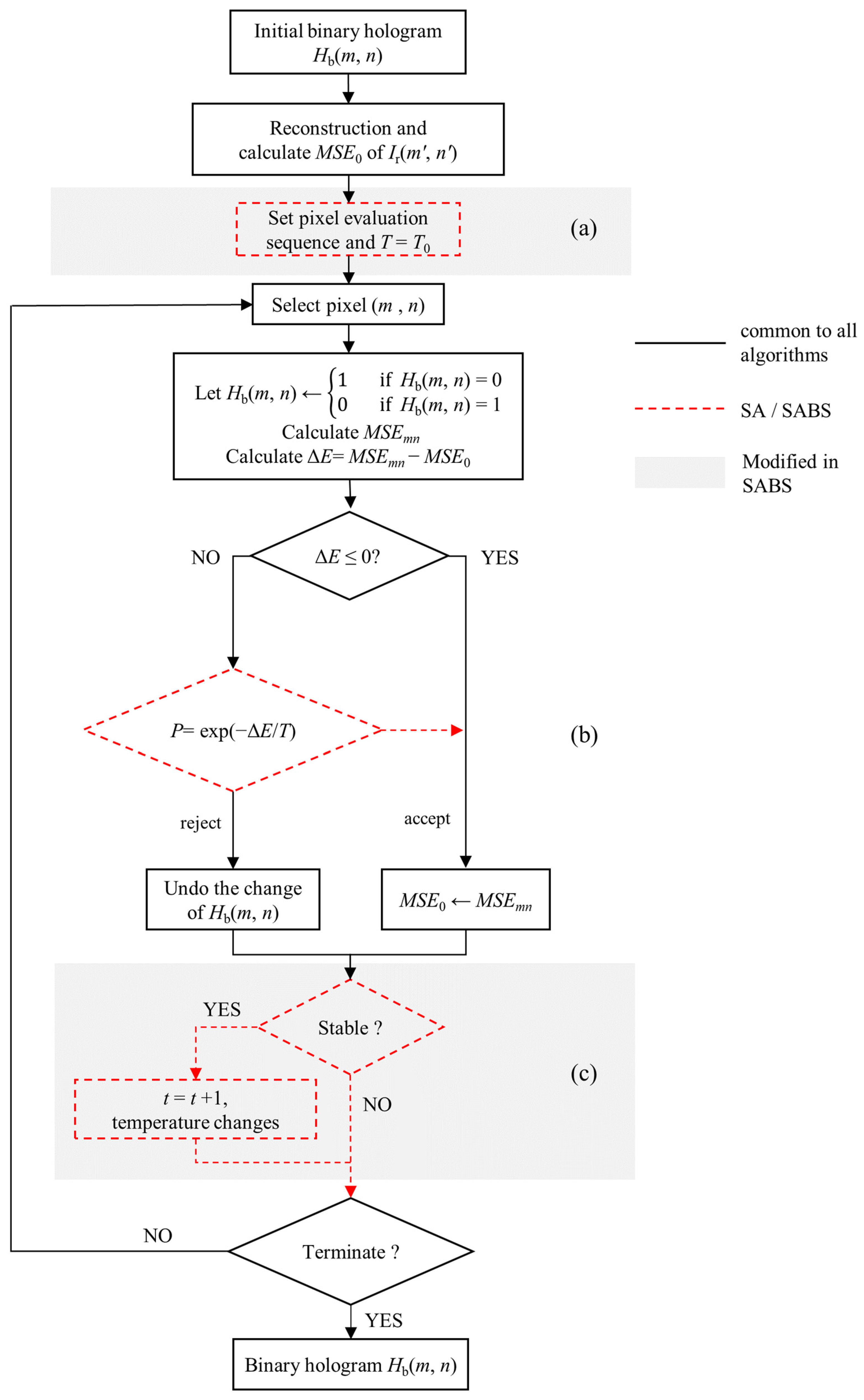

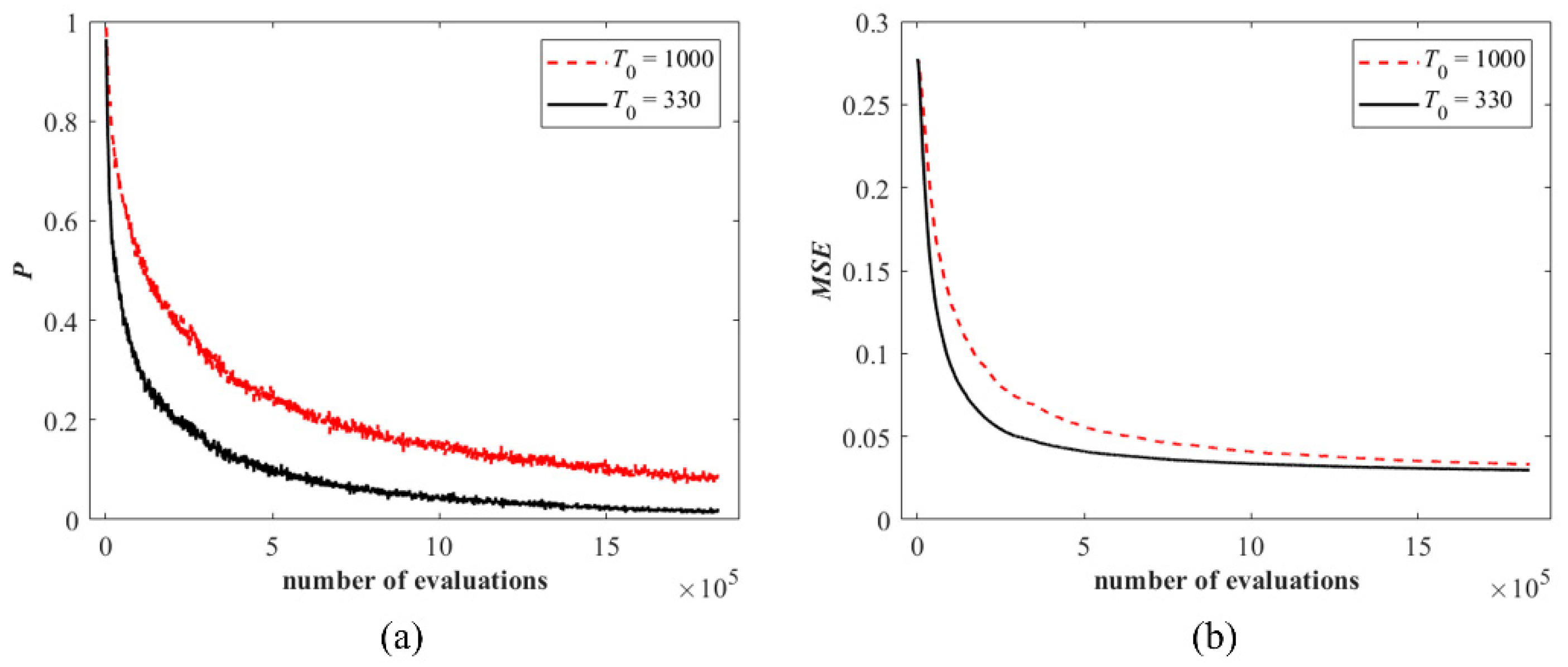
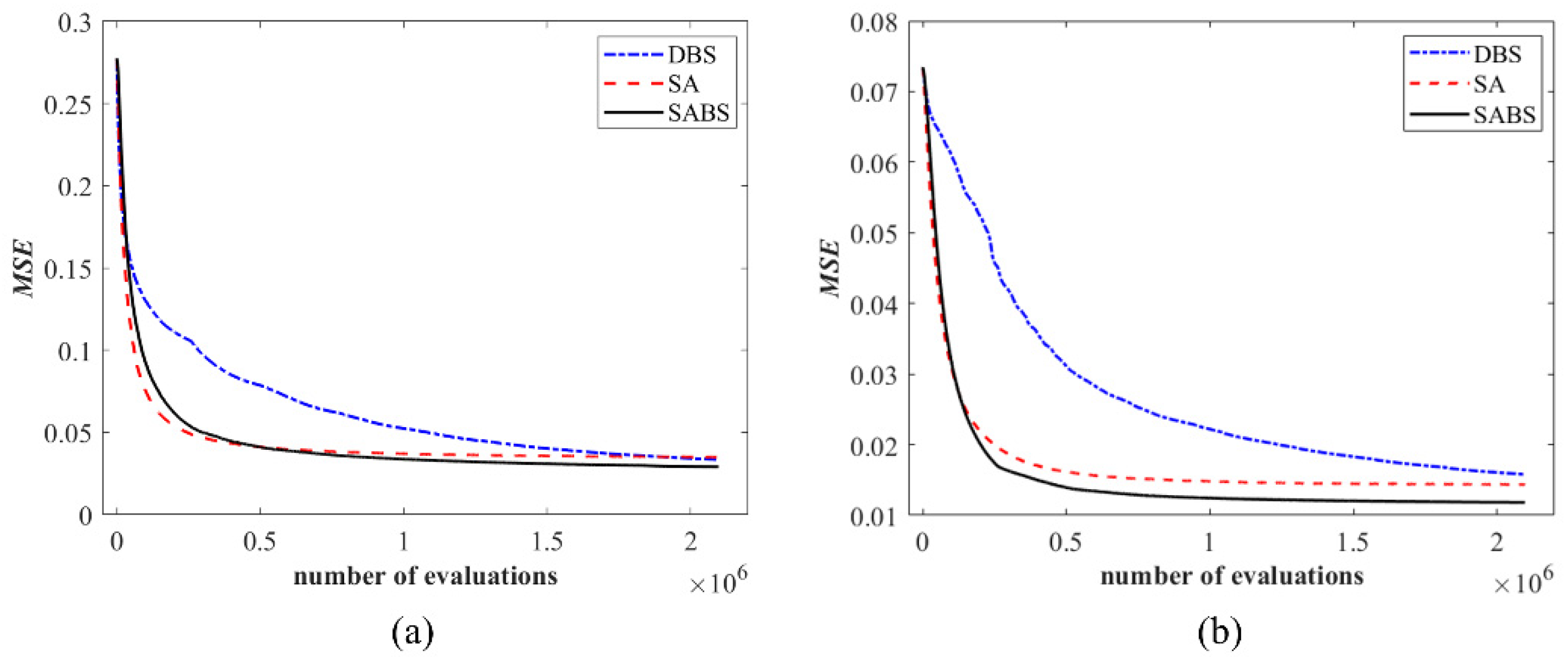
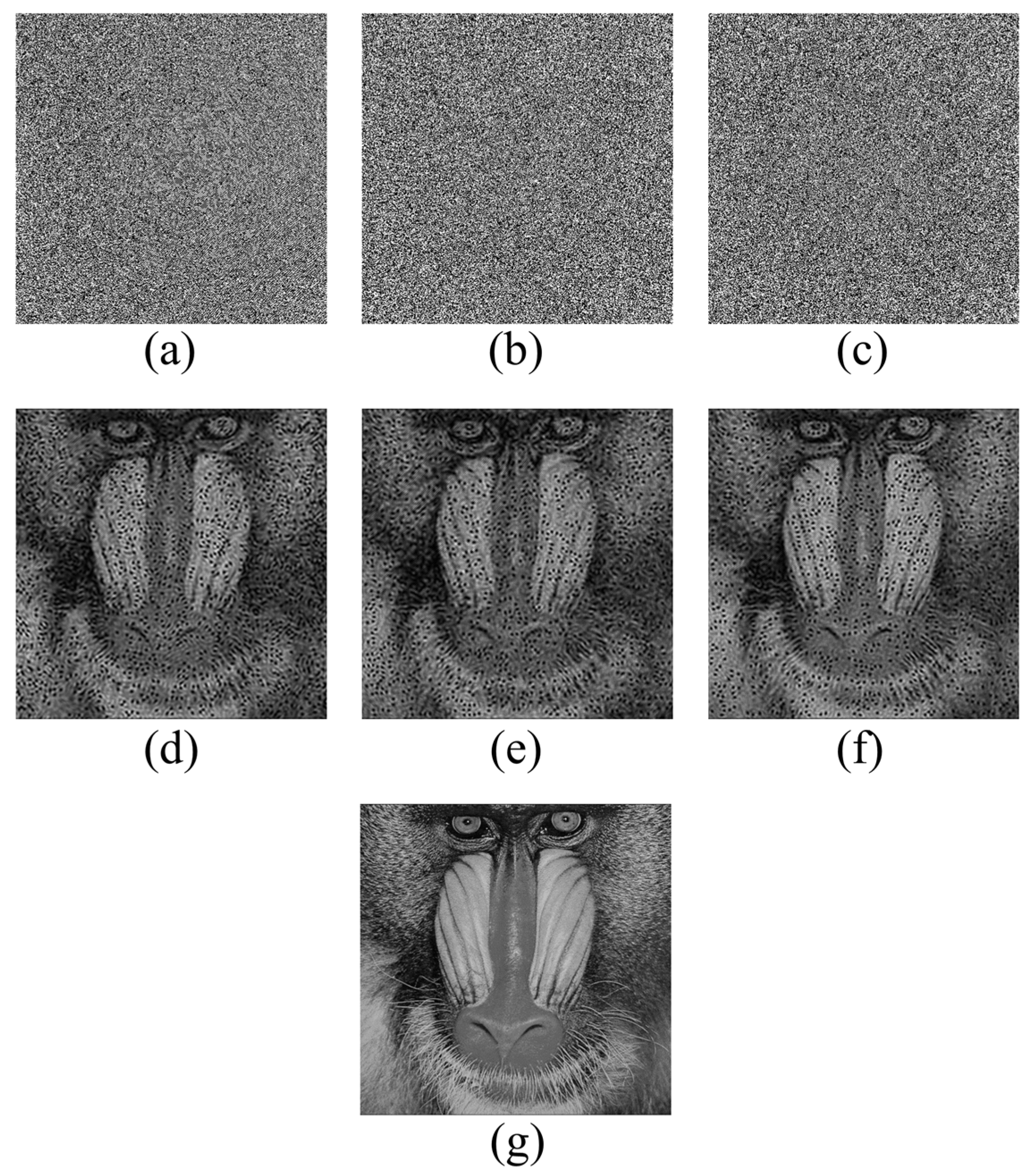
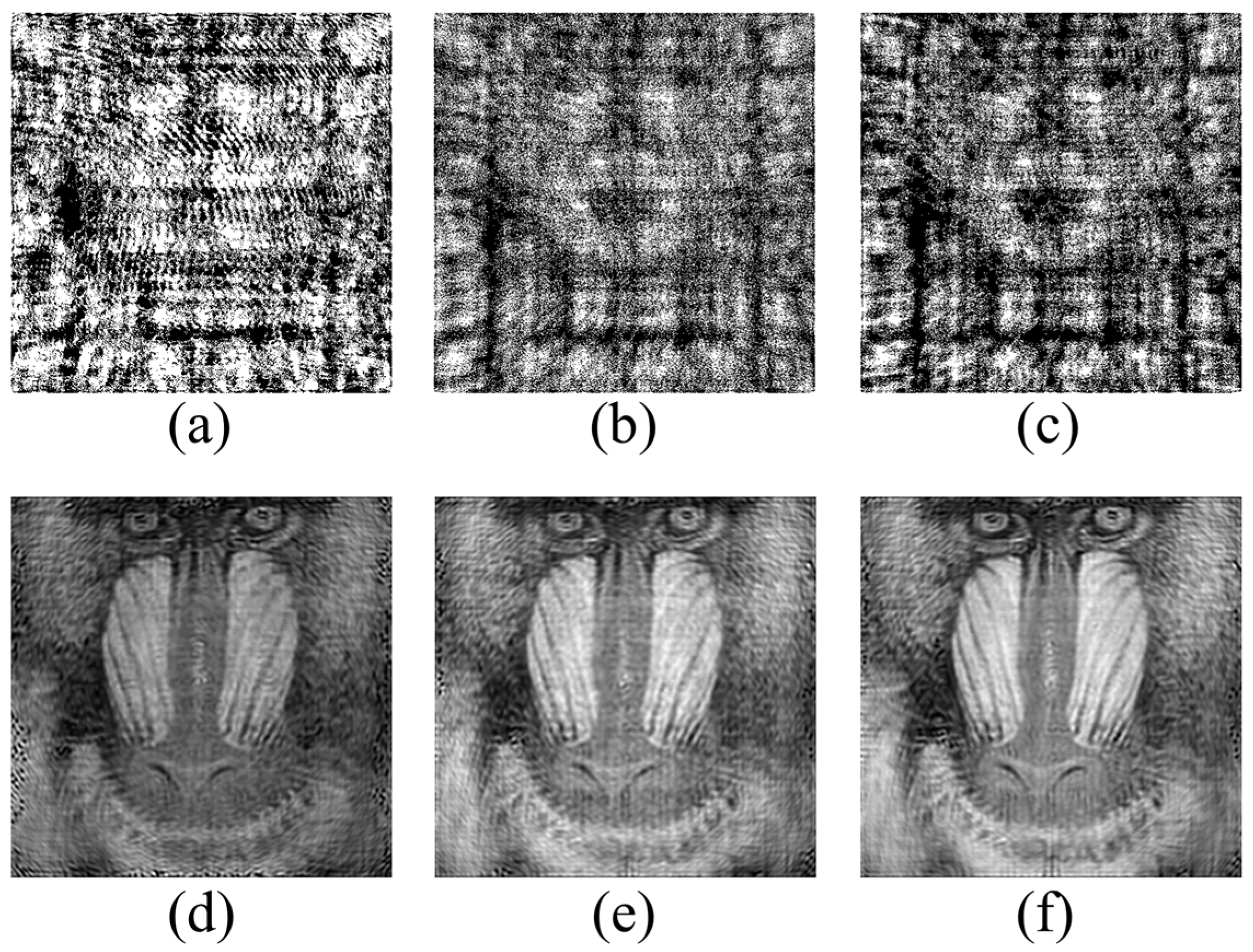
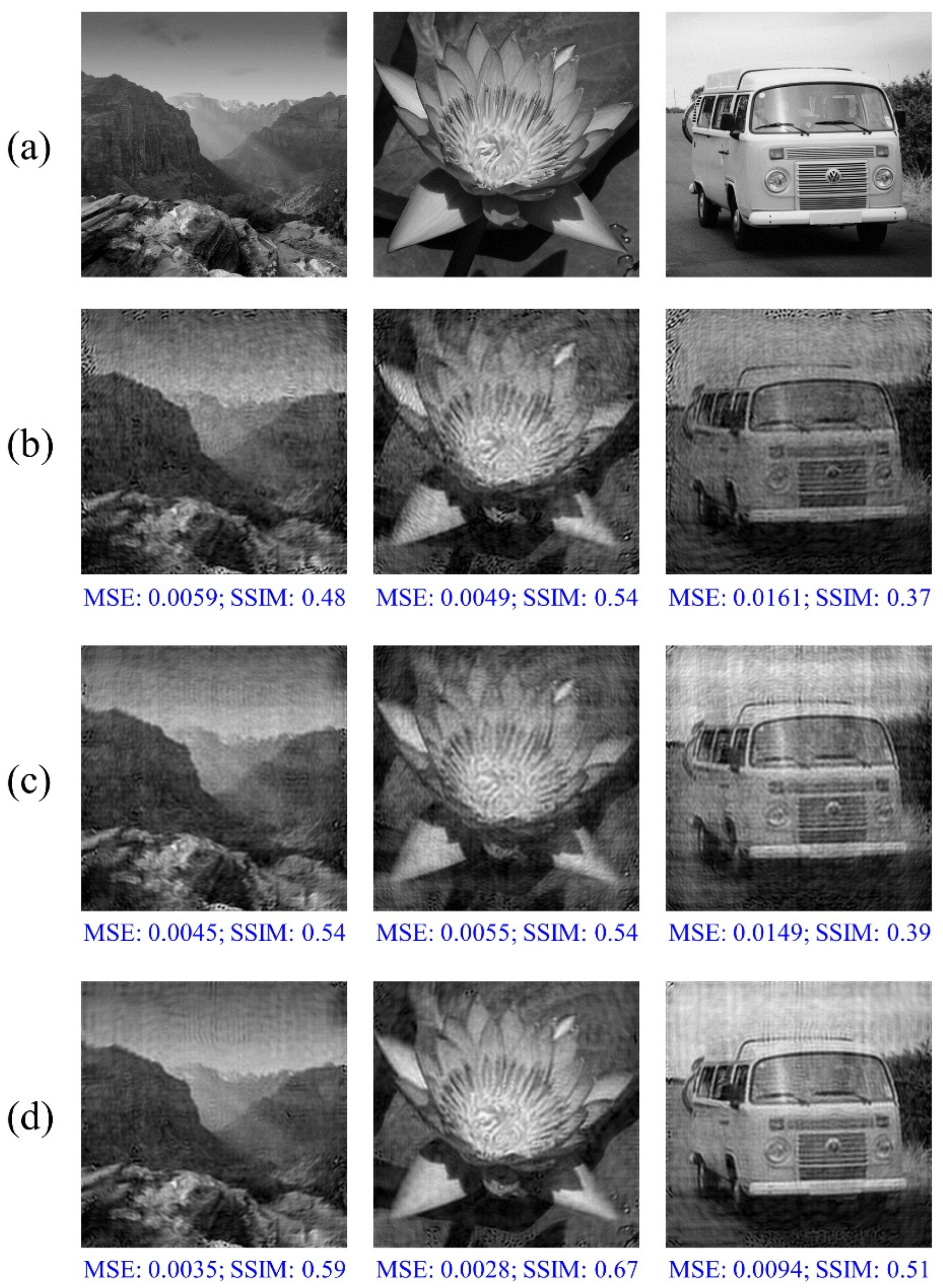
| Metrics | DBS | SA | SABS | |
|---|---|---|---|---|
| off-axis BCGH | MSE | 0.0334 | 0.0349 | 0.0290 |
| SSIM | 0.222 | 0.209 | 0.246 | |
| diffraction efficiency | 3.51% | 1.34% | 1.73% | |
| on-axis BCGH | MSE | 0.0158 | 0.0144 | 0.0118 |
| SSIM | 0.329 | 0.334 | 0.380 | |
| diffraction efficiency | 32.2% | 19.9% | 17.8% |
Publisher’s Note: MDPI stays neutral with regard to jurisdictional claims in published maps and institutional affiliations. |
© 2022 by the authors. Licensee MDPI, Basel, Switzerland. This article is an open access article distributed under the terms and conditions of the Creative Commons Attribution (CC BY) license (https://creativecommons.org/licenses/by/4.0/).
Share and Cite
Liu, J.-P.; Tsai, C.-M. Binary Computer-Generated Holograms by Simulated-Annealing Binary Search. Photonics 2022, 9, 581. https://doi.org/10.3390/photonics9080581
Liu J-P, Tsai C-M. Binary Computer-Generated Holograms by Simulated-Annealing Binary Search. Photonics. 2022; 9(8):581. https://doi.org/10.3390/photonics9080581
Chicago/Turabian StyleLiu, Jung-Ping, and Chen-Ming Tsai. 2022. "Binary Computer-Generated Holograms by Simulated-Annealing Binary Search" Photonics 9, no. 8: 581. https://doi.org/10.3390/photonics9080581
APA StyleLiu, J.-P., & Tsai, C.-M. (2022). Binary Computer-Generated Holograms by Simulated-Annealing Binary Search. Photonics, 9(8), 581. https://doi.org/10.3390/photonics9080581





